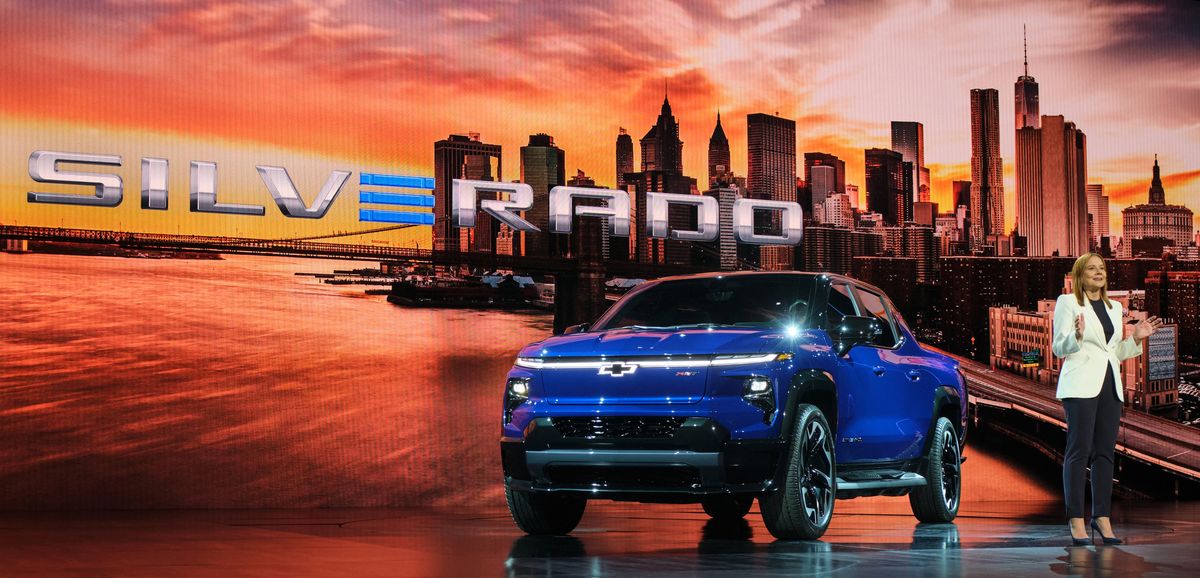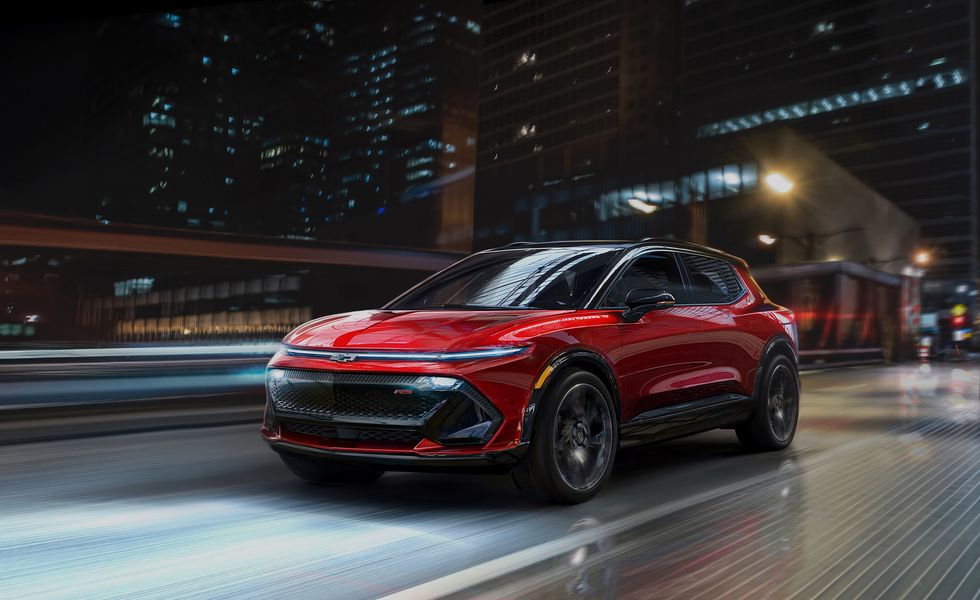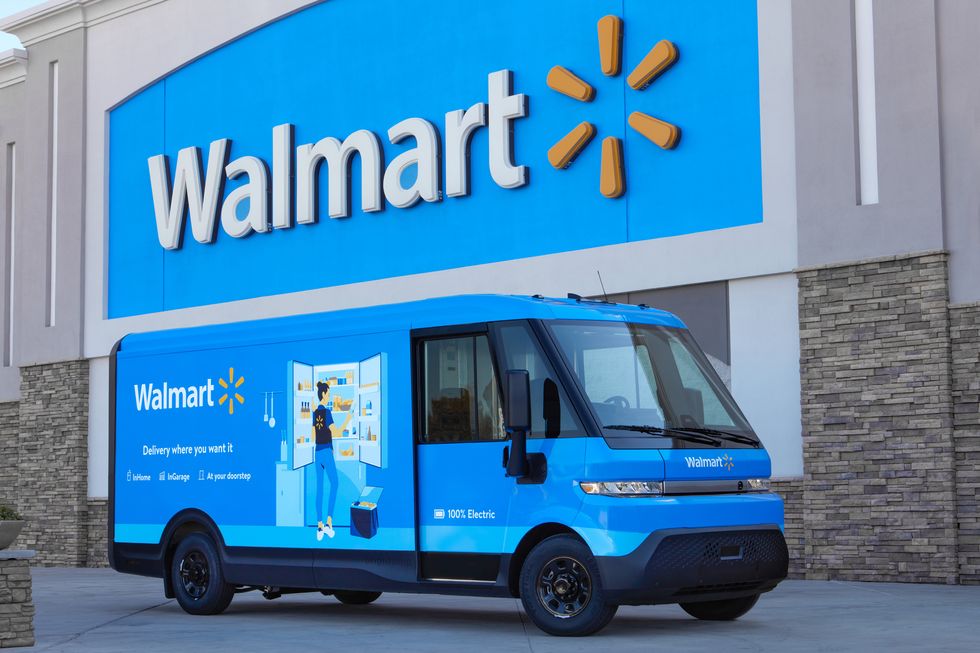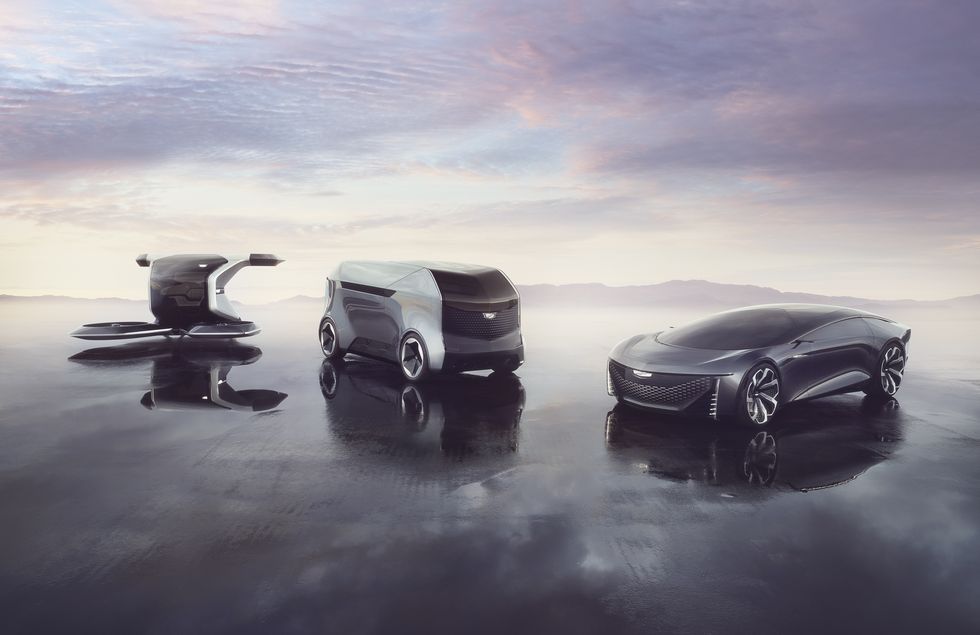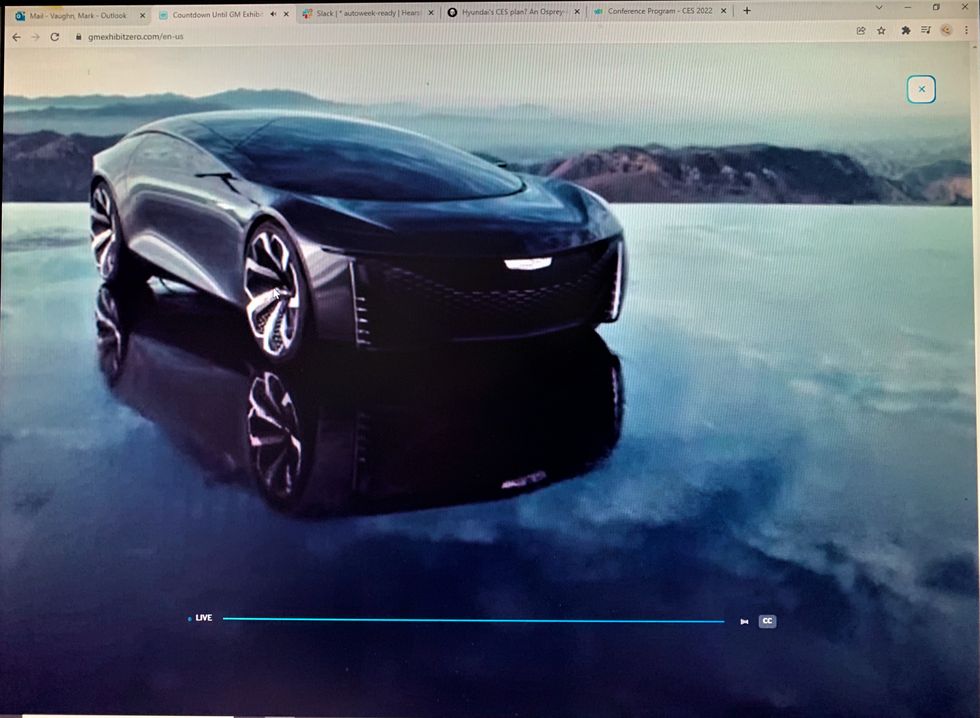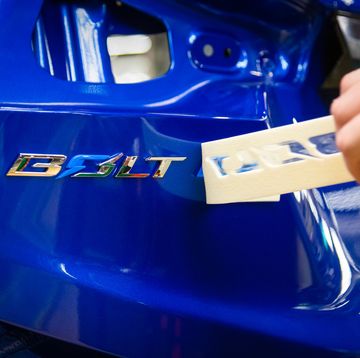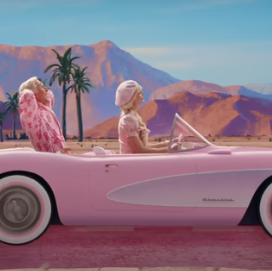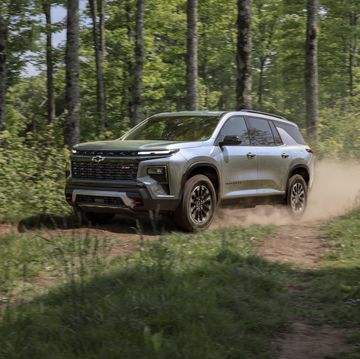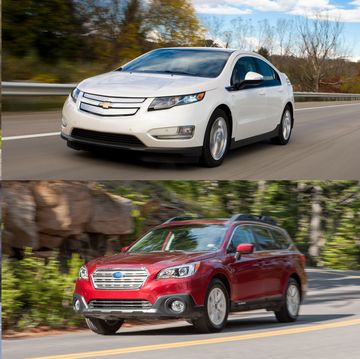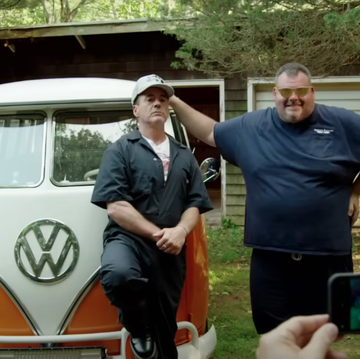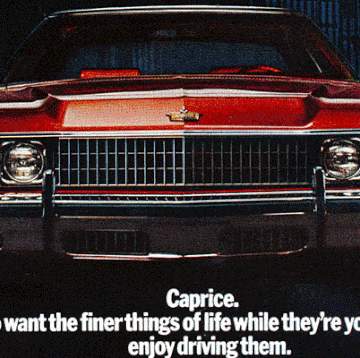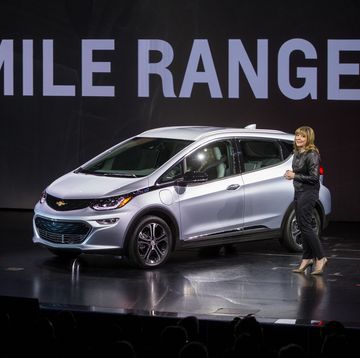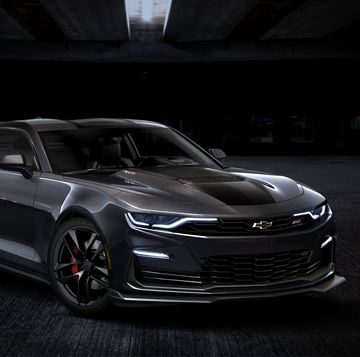- GM CEO Mary Barra laid out the company’s electric and autonomous future in a virtual address timed with CES.
- The Chevrolet Silverado EV pickup is just the first of a continuous flood of EVs on their way to a showroom near you.
- Autonomous vehicles are coming, too, later. And that flying Cadillac from last year’s CES is still on the table.
General Motors CEO Mary Barra used her virtual keynote address from CES to describe what may be the biggest transition in the history of the automotive industry from one of its biggest companies—the switch from internal combustion to electric power and from human-driven to software-driven autonomous vehicles. And yes, they’re still plugging that Cadillac autonomous flying drone taxi from last year.
But it’s the electric vehicles we’ll see first.
“We’re at the tipping point of electrification, and we are expecting this to be a massive year for Chevrolet’s EV future,” Barra said.
Leading the company’s transition is the all-new Chevrolet Silverado EV, an electric pickup truck that is one of at least 19 different planned uses of GM’s Ultium modular platform and battery system. The Ultium idea is to have a basic platform that can be stretched or shrunk to accommodate any number of electric car or truck needs. The Silverado will use the maximum number of cells on the current Ultium menu, a full 200 kWh worth, from which it will get its 400-mile range and 0-60-mph time of under 4.5 seconds. The truck will have an 800-volt pack that can be recharged at up to 350 kW, good for up to 100 miles of range in 10 minutes, GM says. Silverado EV prices will start at $39,900 when that truck comes out next year. Read the full story on Silverado EV here.
The Silverado is just one of many uses for Ultium, Barra stressed. The CEO said that GM’s plan to reach leadership in EV market share in the United States extends well beyond the Chevrolet Silverado EV and will include a Chevy Equinox EV, which will be revealed “very soon,” with an estimated MSRP starting around $30,0000 in the states. Barra flashed a shot of the Equinox on the screen behind her. That vehicle will be in showrooms “next year.” An electric Chevy Blazer will also be available in 2023, Barra said, “with a high level of refinement and options.” All will use versions of GM’s Ultium modular platform and battery system.
“Ultium features a combination of groundbreaking battery architecture, electric propulsion systems, and a common high-energy chemistry-agnostic battery cell that will power an entire range of next-generation electric vehicles,” Barra said in her virtual address. “The same hardware platform that created a supertruck like the GMC Hummer EV will also create the stunning Cadillac Lyric and, soon, higher-volume entries across the globe and across the spectrum of GM brands. That gets us even closer to our vision of a zero-emission and carbon-neutral future.”
GM’s electric aspirations extend beyond its retail business, Barra continued. Through the commercial package delivery company BrightDrop and its surrounding “ecosystem,” that company and its customers “will join GM in the race to help decarbonize e-commerce, which is an exploding as an industry.”
“We delivered our first all-electric delivery vans to FedEx last month, just 20 months after the vehicle was conceived, making the EV600 the fastest vehicle to market in GM’s history,” said BrightDrop CEO Travis Katz.
Indeed, FedEx took delivery of five BrightDrop EV600s in Inglewood, California, “recently,” according to FedEx CEO of the Americas Richard Smith. Last March, FedEx announced a goal of achieving carbon-neutral operations by 2040.
“We envision adding over 200,000 medium-sized electric pickup and delivery vehicles as we march toward our 2040 goal,” said Smith. “Electrifying our pickup and delivery vehicle fleet is a critical component and makes sense from a service and financial standpoint. It translates to more reliable service for our customers, better returns for our shareholders, and stewardship of the environment. A win, win, win.”
Walmart reserved 5000 BrightDrop EVs that will begin hitting the road in 2023.
“If you’re going to start a movement to change the world, you need passionate and like-minded collaborators,” Barra said. “FedEx and Walmart, two of the most respected companies in the world, are all in.”
Enterprise Rent-A-Car will also get on board with its purchase of Silverado EV pickups that you’ll be able to rent starting in 2023.
GM continues to pursue autonomous vehicles, too, Barra said, which it has been working on since its acquisition of Cruise in 2016. Cadillac got the first use of Super Cruise hands-free driver assistance technology in 2017. Cruise the company offers rides in the city of San Francisco right now without a driver present in the car, Barra said. GM, Cruise, and Honda are working to begin commercialization of that technology “in the coming months,” Barra added. GM plans to make Super Cruise available across the majority of its portfolio, Barra said, without saying exactly when.
Beyond Super Cruise, GM’s Ultra Cruise will come next.
“Ultra Cruise is not just a game changer in terms of what it enables—a door-to-door hands-free driving experience—but a technological one as well,” Barra said.
Over-the-air updates will keep the technology up to date. One of the first vehicles to get Ultra Cruise will be the Cadillac Celestiq sedan. As for when that might be out, Barra said only that we would be hearing more in the first half of 2022. The CEO did say to look for “the first personal autonomous vehicle deliveries as soon as the middle of this decade.”
And remember that flying car thing Cadillac showed at CES last year? It’s still on, as part of the Halo Portfolio of fully autonomous luxury transportation.
“We’re continuing to build on the big idea of effortless travel through extraordinary means,” said Mike Simcoe, VP of global design. “The results are stunning transportation experiences in multiple forms that go way beyond four doors and four wheels. That’s what makes the Halo Portfolio so intriguing. It leans into the very real possibilities of personalized autonomous mobility through multiple vehicles, each designed for specific occasions and purposes.”
Including that flying-car two-seater pod thing. Nice to see that it’s still on the table, but can you imagine flying Cadillacs?
Easier to imagine a more traditional-looking car. Simcoe introduced the Inner Space, “a dramatic two-passenger electric and fully autonomous luxury concept.”
“The Inner Space puts human wellness and connection at the center of a driver’s environment, allowing two passengers to focus on their journey,” said Simcoe. “The expansive glass roof and sculpted body side allows unimpeded views, the doors and the roof open as one and the seats pivot outward to create a welcoming and comfortable entry and a thoughtful gracious egress.”
Simcoe did not say when something like the Inner Space—or even the flying-car thing—might make it to market.
“Inner Space and the rest of the Cadillac Halo Portfolio help us to articulate our vision for an autonomous future,” said Barra. “And while they are concepts, our path to autonomy is comprehensive, and very real. In short, we believe GM and Cruise have the technology, expertise and scale to capture both the advanced Driver Assist and driverless AV market opportunities before anyone else.”
The big point may be that there is no turning back. This EV stuff and all this autonomous vehicle research make up the way of the future as far as GM is concerned. So go out in the garage and kiss your carburetor goodbye.
“At today’s General Motors we are witnessing the effects of our transformation from automaker to platform innovator in both practical terms and in mindset,” Barra said. “We’re witnessing what’s possible when innovators and problem solvers embrace the opportunity to change the world, knowing they have the tools and the technology to do precisely that, and to deploy them with unmatched speed and scale. We are expanding our position in autonomous driving and electric vehicles, and we intend to lead in both. When you consider the GM EV portfolio today, and just on the horizon, including BrightDrop electric vans, Chevrolet Silverado EV, Equinox EV, Blazer EV, Bolt EV, GMC Sierra EV, Hummer EV, Cadillac Lyric and Celestiq, no other automaker today matches the depth and the range of GM’s growing all-electric portfolio. Make no mistake, this is a movement.”
Share your thoughts in the comments section below on the wide-ranging goals and promises of electric and autonomous vehicles across the General Motors brands.

